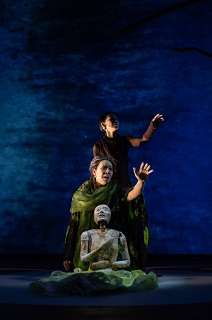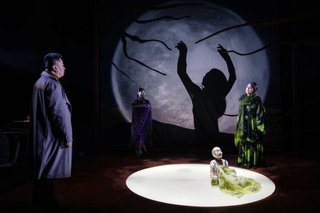|
Back
Garrett Fisher’s Creation of a Universe New York
Baruch Performing Arts Center
01/09/2020 - & January 11, 12, 15, 16, 17, 2020
Garrett Fisher: Blood Moon (World Premiere)
Juecheng Chen (Moon), Takemi Mitamura (Puppeteer, Dancer, Co-Choreographer), Nina Yoshida Nelsen (Aunt), Wei Wu (Nephew)
Kamala Sankaram (Harmonium), Adam Young (Viola da gamba, Cello), Isabel Lepanto (Gleicher, flutes), William Hobbs (Piano, Keyboard), Fum Tanakadate (Taiko, Bamboo flute), Barbara Merjan (Taiko), Steven Osgood (Music Direction)
Rachel Dickstein (Director, Developer, Co-Choreographer), Susan Zeeman Rogers (Scenic Design), Yuki Nakase Link (Lighting Design), Daniel Neumann (Sound Design), Maika Matsushima (Costume Design), Erik Sanko (Puppet Design)

(from top) T. Kitamura, N. Y. Nelsen (© Maria Baranova)
“Her antiquity in preceding and surviving succeeding tellurian generations: her nocturnal predominance: her satellitic dependence: her luminary reflection: her constancy under all her phases, rising and setting by her appointed times, waxing and waning: the forced invariability of her aspect: her indeterminate response to inaffirmative interrogation: her potency over effluent and refluent waters: her power to enamour, to mortify, to invest with beauty, to render insane, to incite to and aid delinquency: the tranquil inscrutability of her visage: the terribility of her isolated dominant resplendent propinquity: her omens of tempest and of calm: the stimulation of her light, her motion and her presence: the admonition of her craters, her arid seas, her silence: her splendour, when visible: her attraction, when invisible.”
Leopold Bloom’s epiphany of Woman and Moon, in James Joyce’s Ulysses
A Joycean “epiphany” well describes visual miracle upon miracle in the latest theater-opera by Garrett Fisher which premiered last night at Baruch Center. Add to this, noting that this was a Beth Morrison production, nothing less than an epiphany could be expected. Ms. Morrison made Bora Yoon magnetic, had brought The Echo Drift to life, and in Philip Venable’s 4.48 Psychosis, had produced for some the most stunning theatrical works in 2019.
With Blood Moon, her universe circles to 15th Century Japan...in a way. For the model of Blood Moon was allegedly a Noh play, with the usual ghosts, forebodings, agonies and a moon–both graphically, visually and dramatically–overlooking llthe entire tragedy.
Yet its Noh origins hardly precluded the use of 21st Century tools, of visual effects ever so subtle, ever so powerful; of a ghost life-size puppet whirled around, deathly, incandescently alive, handled with magical movements by dancer//puppeteer Takemi Kitamura. (And I still don’t know whether the expressions of this cadaver’s face changed from moment to moment, or whether it was the fungible original model by Erik Sanko.)
Above all–even above the poetic drama of a woman left for dead coming back to life found by the man who had killed her–Blood Moon was a production of color. Besides the changing colors of the screen, we had the sapphire-purple frilled color of Tsukuyomi, gesturing, singing bracing herself against the moon. The double-green–translucent and emerald–of dancer and the dead aunt. We had the somber coat of the mourning nephew killer Wei Wu. And the clay-white deadly puppet itself. All in dazzling designs against the Noh-simple setting of a tree branch on the barren stage.
All dominated by the eponymous moon itself. Changing from faraway to closeup to moving with leaves and birds to a moon almost forcing its way onto the stage, the frightening lunar spectacle which inspires murder and sex and ghosts and unworded fascination.
To these eyes, it was reminiscent visually of Lars von Trier’s planet hurtling towards earth in his haunting film Melancholia. Von Trier backed up his phantasmagoria with the Tristan Prelude–the music as obsessive there as the pacing of the film itself.

G. Fisher (© Hayley Young)
Composer Garrett Fisher has never attempted the hermetic eroticism of Wagner. Japanese art would hint, with scintillas of nuance, that kind of of emotion. He has opened himself up to music of Asia, not syncretically like, say, Lou Harrison or Tan Dun’s Marco Polo. Rather, in Blood Moon, he used his “ensembles”–two of them–to embrace the emotions.
On one side of the stage were two sets of percussion. The “overture” banged away, then chattered on small drums until entrance of the dancer. The second ensemble, on the other side of the stage, deftly conducted by Stephen Osgood, was eclectic–in time and space. Cellist Adam Young played viola da gamba when necessary. Fumi Tanakadate (with Barbara Merjan) played the soft taiko drum, but also took to the bamboo flute. Add to this a harmonium and more flutes, and one had music which was Japanese and Renaissance, and–in the two vocal ensembles–almost late 19th Century Italian.
The music was not startling like the stage colors, but it was appropriate. Most important, because Mr. Fisher was using such an original ensemble, the music had its own originality which could never be pigeonholed.

W. Wu, J. Chen, N. Y. Nelsen (© Maria Baranova)
If one couldn’t understand all the singing, distinguished by Asian melismae, by deep tones (by Wei Wu) and the faraway singing of the moon, one could at least read the surtitles far above the stage. Admittedly, I was so riveted by the action on the stage, which included dance, silhouettes, eerie movements, that not until the middle of Blood Moon did I realize that story would have been more intelligible had I noticed the faint words of Ellen McLaughlin’s libretto.
My apologies.
Except not apologies. Frequently I had heard opera in China with no knowledge of the story. I had seen Japanese drama in Kyoto, with only the faintest idea of what was happening.
On the other hand, isn’t this the point of art, according to Antonin Artaud? That one is suddenly transported to another world, a world with only the faintest dramatic or linguistic relation to our own. Whether the grand composer, librettist, huge crew and splendid artists of Blood Moon meant this or not, the production on the stage gave us a whole new universe in which to delve. Not to understand, not to debate, but to encounter, embrace and, at times, to dream.
Harry Rolnick
|